50 “Healthy” Snacks That Are Destroying Your Body ( courtecy;- reader's digest )BY KIMBERLY HISS They can sabotage your health with sneaky calories or toxins in the packaging.
- লিঙ্ক পান
- X
- ইমেল
- অন্যান্য অ্যাপ
Whether because of the sneaky calories you don't realize you're getting, or the toxins in the packaging you never suspected were there, there are many snacks that could be sabotaging your health. Here are the top offenders.
Frozen yogurt
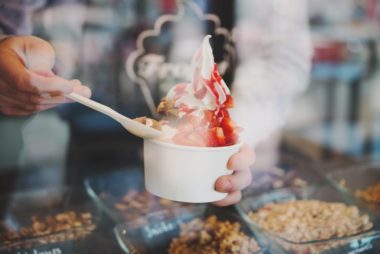 VERYULISSA/SHUTTERSTOCKWhile fro yo itself is a good treat, it's easy to eat it the wrong way. "People go to a frozen yogurt place and think 'Hooray, I'm being so good by having yogurt instead of ice cream, I can pile peanut butter cups and chocolate syrup on top.' What was initially a good choice is now 600 to 900 calories," says Angel Planells, MS, RDN, Seattle-based founder of ACP Nutrition, and spokesperson for the Academy of Nutrition and Dietetics. Your best bet instead is to go light on the extras, he suggests: "Two or three toppings max—think fruit, nuts, maybe a small drizzle of chocolate syrup—otherwise you may as well just eat some ice cream." For more frozen snack variety, try one of these summer treats.
VERYULISSA/SHUTTERSTOCKWhile fro yo itself is a good treat, it's easy to eat it the wrong way. "People go to a frozen yogurt place and think 'Hooray, I'm being so good by having yogurt instead of ice cream, I can pile peanut butter cups and chocolate syrup on top.' What was initially a good choice is now 600 to 900 calories," says Angel Planells, MS, RDN, Seattle-based founder of ACP Nutrition, and spokesperson for the Academy of Nutrition and Dietetics. Your best bet instead is to go light on the extras, he suggests: "Two or three toppings max—think fruit, nuts, maybe a small drizzle of chocolate syrup—otherwise you may as well just eat some ice cream." For more frozen snack variety, try one of these summer treats.Flavored yogurt
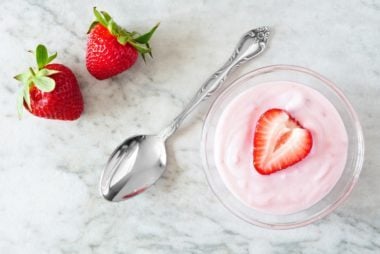 JENIFOTO/SHUTTERSTOCK"I get it, some people just aren't fans of plain yogurt," Planells concedes. "But when you have flavored yogurt, you're getting additional sugar." Rather than subjecting yourself to all the added sweeteners from a company, have plain yogurt and add fresh fruit yourself, he recommends. "You could go to the store and get Brand X yogurt with 35 grams of added sugar, or you could have plain yogurt and a handful of blueberries for only 15 to 20 grams—and still get the sweetness." Consider these 10 healthy yogurt toppings to keep things interesting.
JENIFOTO/SHUTTERSTOCK"I get it, some people just aren't fans of plain yogurt," Planells concedes. "But when you have flavored yogurt, you're getting additional sugar." Rather than subjecting yourself to all the added sweeteners from a company, have plain yogurt and add fresh fruit yourself, he recommends. "You could go to the store and get Brand X yogurt with 35 grams of added sugar, or you could have plain yogurt and a handful of blueberries for only 15 to 20 grams—and still get the sweetness." Consider these 10 healthy yogurt toppings to keep things interesting.Your co-worker's candy bowl
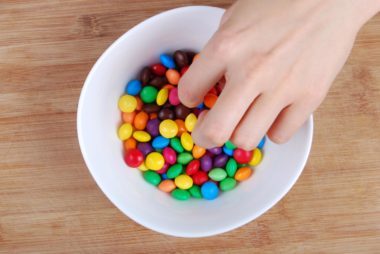 IKINDI/SHUTTERSTOCKIf you're trying to focus at work but notice your energy level dropping, it's all too easy to reach for the worst thing for you: The sugary snack. "You have a piece of candy and get that immediate burst of energy entering your blood stream, but it only lasts a short period then drops," says Libby Mills, MS, RDN, a Philadelphia-based nutrition and cooking coach, and spokesperson for the Academy of Nutrition and Dietetics. "There's such a thing as rebound hypoglycemia, which is when your body feels worse after eating a cookie or candy because your blood sugar falls perhaps even lower than where it was before you had the sugary snack." Such a drop could prompt you to reach for another piece of candy for more sugar, setting up a bad cycle. (Did you know there's a scientific reason you can't resist pink and red candy?)
IKINDI/SHUTTERSTOCKIf you're trying to focus at work but notice your energy level dropping, it's all too easy to reach for the worst thing for you: The sugary snack. "You have a piece of candy and get that immediate burst of energy entering your blood stream, but it only lasts a short period then drops," says Libby Mills, MS, RDN, a Philadelphia-based nutrition and cooking coach, and spokesperson for the Academy of Nutrition and Dietetics. "There's such a thing as rebound hypoglycemia, which is when your body feels worse after eating a cookie or candy because your blood sugar falls perhaps even lower than where it was before you had the sugary snack." Such a drop could prompt you to reach for another piece of candy for more sugar, setting up a bad cycle. (Did you know there's a scientific reason you can't resist pink and red candy?)Rice cakes
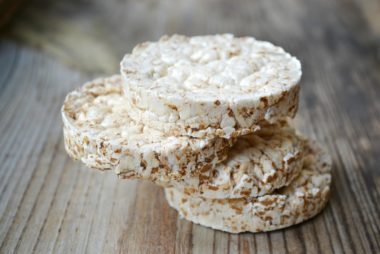 MMKARABELLA/SHUTTERSTOCKOK, so rice cakes may seem the very definition of a healthy snack, but they still come with concerns. Although they're low in calories, they're made from processed white rice, which is high in carbohydrates that could spike your blood sugar levels, says Shape.com. And if you choose a brand with flavorings, you're also consuming extra salt and sugar. "So even if your net calories are low, munching on these nutrient-void disks is about as healthy (and tasty) as eating Styrofoam packing peanuts," Shape.com concludes. Here are some other unhealthy foods you've been tricked into thinking are good for you.
MMKARABELLA/SHUTTERSTOCKOK, so rice cakes may seem the very definition of a healthy snack, but they still come with concerns. Although they're low in calories, they're made from processed white rice, which is high in carbohydrates that could spike your blood sugar levels, says Shape.com. And if you choose a brand with flavorings, you're also consuming extra salt and sugar. "So even if your net calories are low, munching on these nutrient-void disks is about as healthy (and tasty) as eating Styrofoam packing peanuts," Shape.com concludes. Here are some other unhealthy foods you've been tricked into thinking are good for you.Pretzels and other processed foods
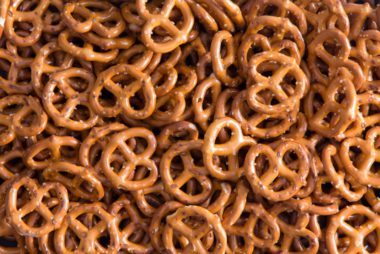 OZGUR COSKUN/SHUTTERSTOCK"I see lots of folks reaching for pretzels because they're low-fat or fat-free, and maybe they're made with less sodium, which is awesome," says Mills. "But in general, these snack foods have been processed in such a way that you're not getting the maximum nutrition." For example, foods from pretzels to muffins can be made with white flour—as opposed to healthier whole grains—which digests very quickly and therefore acts similarly to eating a sugary snack: you'll get that initial energy burst, but it may not last. Reach for one of these healthy snacks instead.
OZGUR COSKUN/SHUTTERSTOCK"I see lots of folks reaching for pretzels because they're low-fat or fat-free, and maybe they're made with less sodium, which is awesome," says Mills. "But in general, these snack foods have been processed in such a way that you're not getting the maximum nutrition." For example, foods from pretzels to muffins can be made with white flour—as opposed to healthier whole grains—which digests very quickly and therefore acts similarly to eating a sugary snack: you'll get that initial energy burst, but it may not last. Reach for one of these healthy snacks instead.Trail mix
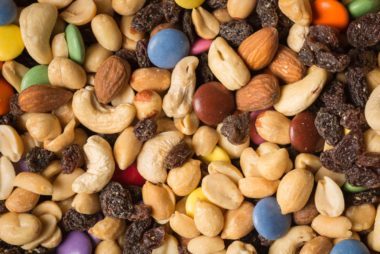 COOKIESFORDEVO/SHUTTERSTOCKNuts and dried fruit mixed together? Sounds pretty healthy. And if you stick to a responsible portion size of a brand that uses plain, unsweetened dried fruits and unsalted nuts, it just may be, says Shape.com. The problem is that many mixes include add-in's like chocolate chips and M&M's, which introduce excess salt and sugars. "Since a small handful easily contains 300-plus calories, read your nutrition labels closely!" the site warns. (These are the top 5 healthiest nuts you can eat.)
COOKIESFORDEVO/SHUTTERSTOCKNuts and dried fruit mixed together? Sounds pretty healthy. And if you stick to a responsible portion size of a brand that uses plain, unsweetened dried fruits and unsalted nuts, it just may be, says Shape.com. The problem is that many mixes include add-in's like chocolate chips and M&M's, which introduce excess salt and sugars. "Since a small handful easily contains 300-plus calories, read your nutrition labels closely!" the site warns. (These are the top 5 healthiest nuts you can eat.)Fat-free cheese
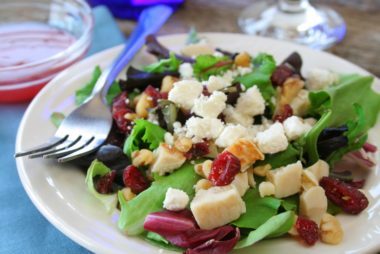 DARRENKDOTFISHER/SHUTTERSTOCKWhile "Fat-Free!" looks good on everything from cheese sticks to salad dressing bottles, there are three things you need to realize, Planells explains. First, some fats are healthy: "When you're consuming fat-free foods, you're missing out on some heart healthy fats, such as poly- and mono-unsaturated fats, as well as omega 3 fatty acids." Second, you're likely consuming fat replacements: "When foods are fat free, extra sugar or extra sodium is often added to compensate for the lost flavor." Third, you could overeat: "Due to the lack of fat, we could not feel satisfied from our snack choice, potentially leading to overeating." Find out other dairy myths you need to stop believing.
DARRENKDOTFISHER/SHUTTERSTOCKWhile "Fat-Free!" looks good on everything from cheese sticks to salad dressing bottles, there are three things you need to realize, Planells explains. First, some fats are healthy: "When you're consuming fat-free foods, you're missing out on some heart healthy fats, such as poly- and mono-unsaturated fats, as well as omega 3 fatty acids." Second, you're likely consuming fat replacements: "When foods are fat free, extra sugar or extra sodium is often added to compensate for the lost flavor." Third, you could overeat: "Due to the lack of fat, we could not feel satisfied from our snack choice, potentially leading to overeating." Find out other dairy myths you need to stop believing.Flavored soy milk
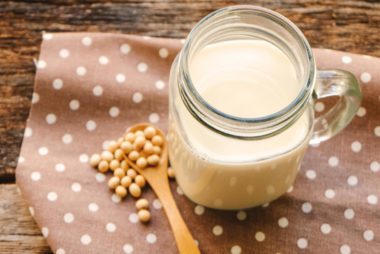 AUKARAWATCYBER/SHUTTERSTOCKIf you're considering buying soy milk you're off to a great start; this beverage is low in cholesterol and high in potassium and protein. But if, instead of plain soy milk, you choose the chocolate or vanilla version, you're taking a big step back. "They add so much sugar and unnecessary calories," says Shape.com. "Save the flavored soy milks for the occasional dessert and choose unsweetened or plain varieties for your everyday drinking instead." (Here are some other healthy swaps to make if you want to ditch dairy.)
AUKARAWATCYBER/SHUTTERSTOCKIf you're considering buying soy milk you're off to a great start; this beverage is low in cholesterol and high in potassium and protein. But if, instead of plain soy milk, you choose the chocolate or vanilla version, you're taking a big step back. "They add so much sugar and unnecessary calories," says Shape.com. "Save the flavored soy milks for the occasional dessert and choose unsweetened or plain varieties for your everyday drinking instead." (Here are some other healthy swaps to make if you want to ditch dairy.)Granola
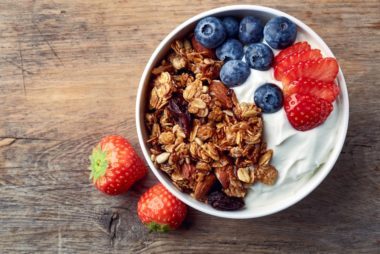 BAIBAZ/SHUTTERSTOCKAlthough this snack conjures images of hiking and nature, it's not always the best choice. "Granola definitely has a health halo around it that makes you think, 'Oh I'm eating granola, I'm being good!'" says Planells. But this snack carries the twin pitfalls of portion size problems and added sweetness. "Granola is usually sweetened, so you're getting extra sugar in the mix," Planells points out. "It's more decadent than having plain cereal, such as oatmeal. So if you do eat granola, either go for the unsweetened variety or be mindful of your portions." Or for more control over the ingredients, try our recipe for homemade granola.
BAIBAZ/SHUTTERSTOCKAlthough this snack conjures images of hiking and nature, it's not always the best choice. "Granola definitely has a health halo around it that makes you think, 'Oh I'm eating granola, I'm being good!'" says Planells. But this snack carries the twin pitfalls of portion size problems and added sweetness. "Granola is usually sweetened, so you're getting extra sugar in the mix," Planells points out. "It's more decadent than having plain cereal, such as oatmeal. So if you do eat granola, either go for the unsweetened variety or be mindful of your portions." Or for more control over the ingredients, try our recipe for homemade granola.Reduced-fat peanut butter
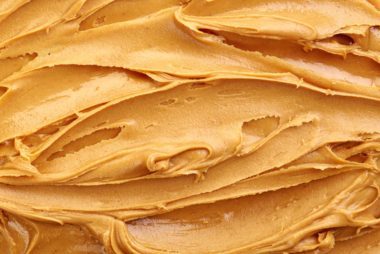 MARAZE/SHUTTERSTOCKWhat could be better than getting a yummy snack like peanut butter with fewer fats? It's actually smarter to avoid the reduced-fat version. "Peanuts are full of healthy monounsaturated fats, so when it comes to choosing a peanut butter, it's best to go with a natural version of the full-fat variety," says Shape.com. "Most reduced-fat versions contain the same number of calories per serving because when they take the fat out, they add sugar and other fillers in. Ick!" If you're tired of peanut butter, try one of these five alternatives to peanut butter.
MARAZE/SHUTTERSTOCKWhat could be better than getting a yummy snack like peanut butter with fewer fats? It's actually smarter to avoid the reduced-fat version. "Peanuts are full of healthy monounsaturated fats, so when it comes to choosing a peanut butter, it's best to go with a natural version of the full-fat variety," says Shape.com. "Most reduced-fat versions contain the same number of calories per serving because when they take the fat out, they add sugar and other fillers in. Ick!" If you're tired of peanut butter, try one of these five alternatives to peanut butter.Anything you eat too close to a meal
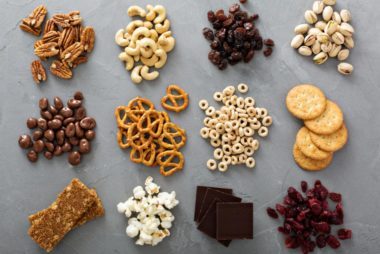 ELENA VESELOVA/SHUTTERSTOCKWhatever you're snacking on, be sure to leave adequate time before your next meal. "Let's say you're eating dinner at 7; the latest you'd want to have a snack is 5, because by 7 if you're still digesting that snack you're less likely to eat dinner," says Planells. "In general, it's best to have a snack two to three hours before a meal." (If you are going to snack, try to choose a healthy one–like these 30 snacks that will satisfy your cravings and help you lose weight.)
ELENA VESELOVA/SHUTTERSTOCKWhatever you're snacking on, be sure to leave adequate time before your next meal. "Let's say you're eating dinner at 7; the latest you'd want to have a snack is 5, because by 7 if you're still digesting that snack you're less likely to eat dinner," says Planells. "In general, it's best to have a snack two to three hours before a meal." (If you are going to snack, try to choose a healthy one–like these 30 snacks that will satisfy your cravings and help you lose weight.)Anything you nibble for too long
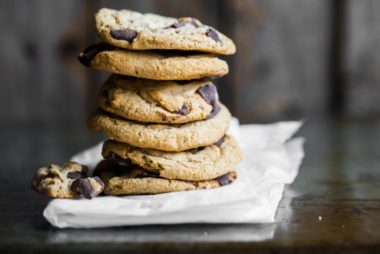 ALENA HAURYLIKWhile spacing your snacks is a good idea, eating each snack promptly is an even better one. "The longer our teeth are exposed to foods, especially foods with carbohydrates, the greater the potential for cavities," Planells explains. "Let's say I eat a few cookies in two minutes or I gradually pick at a few cookies over an hour—all that long-term exposure will increase the bacterial activity in the mouth and promote cavities, so it's better to consume snacks straight up rather than nibbling." For extra protection, brush, floss, or simply drink water after a snack. These oral hygiene tips will help keep your teeth whiter and brighter.
ALENA HAURYLIKWhile spacing your snacks is a good idea, eating each snack promptly is an even better one. "The longer our teeth are exposed to foods, especially foods with carbohydrates, the greater the potential for cavities," Planells explains. "Let's say I eat a few cookies in two minutes or I gradually pick at a few cookies over an hour—all that long-term exposure will increase the bacterial activity in the mouth and promote cavities, so it's better to consume snacks straight up rather than nibbling." For extra protection, brush, floss, or simply drink water after a snack. These oral hygiene tips will help keep your teeth whiter and brighter.Parfait
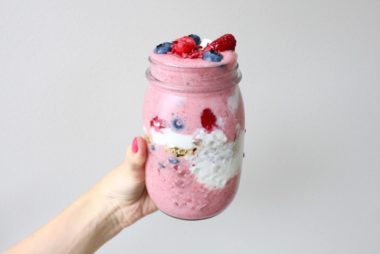 SIGNE-LETH/SHUTTERSTOCKWith this yogurt-granola-and-fresh-fruit snack, the problem is largely the portion size. Unless you make it at home, "this 'healthy' snack can easily contain heavy dessert-like numbers for calories, fat, and sugar," according to Shape.com. "When in doubt, just eat some fresh fruit instead." (These are 10 of the healthiest fruits for your body.)
SIGNE-LETH/SHUTTERSTOCKWith this yogurt-granola-and-fresh-fruit snack, the problem is largely the portion size. Unless you make it at home, "this 'healthy' snack can easily contain heavy dessert-like numbers for calories, fat, and sugar," according to Shape.com. "When in doubt, just eat some fresh fruit instead." (These are 10 of the healthiest fruits for your body.)Coffee
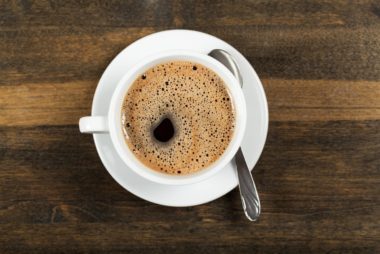 BILLION PHOTOS/SHUTTERSTOCKMany of us think of coffee as a calorie-less snack that's great at combating a dip in energy. "While that's true and coffee can be a good choice, remember that your body might actually be telling you something with that energy lull," says Mills, explaining that some calories may in fact be in order. "Drinking coffee might disguise your hunger, but if you're denying your body sustenance at some point it will catch up with you—especially in the afternoon you could be setting yourself up for being starving for dinner, at which point you'll consume everything in sight." Find out how to hack the Starbucks' menu for healthier drinks.
BILLION PHOTOS/SHUTTERSTOCKMany of us think of coffee as a calorie-less snack that's great at combating a dip in energy. "While that's true and coffee can be a good choice, remember that your body might actually be telling you something with that energy lull," says Mills, explaining that some calories may in fact be in order. "Drinking coffee might disguise your hunger, but if you're denying your body sustenance at some point it will catch up with you—especially in the afternoon you could be setting yourself up for being starving for dinner, at which point you'll consume everything in sight." Find out how to hack the Starbucks' menu for healthier drinks.Multi-grain chips
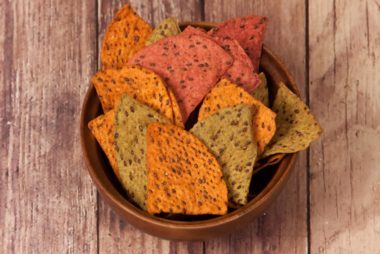 LORRAINE-KOURAFAS/SHUTTERSTOCKYes, they're probably better than potato chips, but it's precisely because you think they're healthier that you tend to eat more than you should. "Unless you're indulging, get your whole grains from more nutritious sources such as quinoa, wild rice, or beans," Shape.com recommends. (Here are 7 convincing ways beans blast fat and curb cravings.)
LORRAINE-KOURAFAS/SHUTTERSTOCKYes, they're probably better than potato chips, but it's precisely because you think they're healthier that you tend to eat more than you should. "Unless you're indulging, get your whole grains from more nutritious sources such as quinoa, wild rice, or beans," Shape.com recommends. (Here are 7 convincing ways beans blast fat and curb cravings.)Salted or flavored nuts
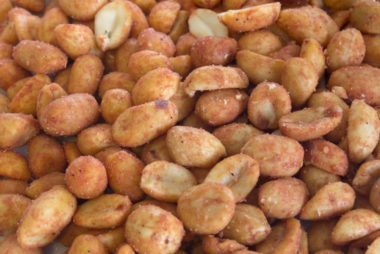 DANA ZURKI/SHUTTERSTOCKYou're so close to a healthy snack by choosing nuts, but if you pick ones with added salts or flavors, you're tipping the scales to the unhealthy end. "If you look at a nut section you'll see 'roasted,' 'ranch,' and 'barbecued,'" says Planells. "But many people already get enough salt as it is—the average American consumes 3,400 mg of sodium daily! Nuts are a great snack option, just save on the salt by choosing the unsalted version." (Here are some signs you're eating too much salt.)
DANA ZURKI/SHUTTERSTOCKYou're so close to a healthy snack by choosing nuts, but if you pick ones with added salts or flavors, you're tipping the scales to the unhealthy end. "If you look at a nut section you'll see 'roasted,' 'ranch,' and 'barbecued,'" says Planells. "But many people already get enough salt as it is—the average American consumes 3,400 mg of sodium daily! Nuts are a great snack option, just save on the salt by choosing the unsalted version." (Here are some signs you're eating too much salt.)Those sugary sodas...
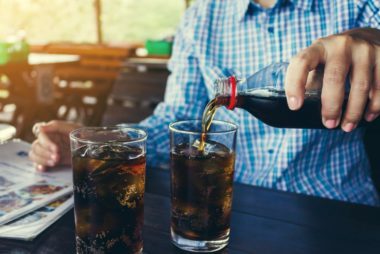 KAZITAFAHNIZEER/SHUTTERSTOCK"I had a client who ate very well—lots of rice and veggies—but he was gaining weight," Planells remembers. "So we looked at his beverage intake, and he was drinking almost 10,000 calories a day!" Many of us just don't perceive beverages in the same way as foods, he explains. "When we consume liquid calories they go down very easy—without the same satiety indicator that might register when digesting an apple—so the calories we get through drinking might not feel like calories at all." One of the two beverage types Planells finds most problematic is soda. "The flavor, the carbonation, the caffeine feels great, but there's no protein or fiber in the mix so you won't feel satisfied. A 12-oz soda can contains 31 to 49 grams of sugar, and it adds up when you have a larger serving or refills." Here are ten more reasons to avoid all soda.
KAZITAFAHNIZEER/SHUTTERSTOCK"I had a client who ate very well—lots of rice and veggies—but he was gaining weight," Planells remembers. "So we looked at his beverage intake, and he was drinking almost 10,000 calories a day!" Many of us just don't perceive beverages in the same way as foods, he explains. "When we consume liquid calories they go down very easy—without the same satiety indicator that might register when digesting an apple—so the calories we get through drinking might not feel like calories at all." One of the two beverage types Planells finds most problematic is soda. "The flavor, the carbonation, the caffeine feels great, but there's no protein or fiber in the mix so you won't feel satisfied. A 12-oz soda can contains 31 to 49 grams of sugar, and it adds up when you have a larger serving or refills." Here are ten more reasons to avoid all soda....Especially sugary sodas containing BVO
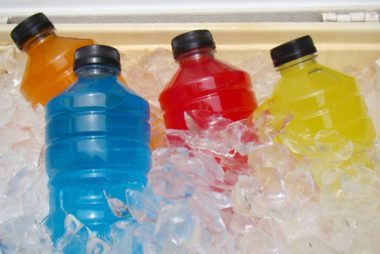 CHUCK WAGNER/SHUTTERSTOCKBrominated vegetable oil (BVO) is an additive that can be used in some sodas and sports drinks to keep citrus flavors from separating out, says the Mayo Clinic, which explains, "Health concerns about BVO stem from the fact that it contains bromine, the element found in brominated flame retardants. Only a few studies have looked at possible safety issues, but it appears that bromine builds up in the body." There have been reports of people noticing skin and nerve problems as well as memory loss after drinking more than two liters a day of soda containing BVO, adds the Mayo Clinic; some manufacturers have removed the substance—already banned as a food additive in Europe and Japan—from their products. (Here are some other U.S. ingredients that are banned in other countries.)
CHUCK WAGNER/SHUTTERSTOCKBrominated vegetable oil (BVO) is an additive that can be used in some sodas and sports drinks to keep citrus flavors from separating out, says the Mayo Clinic, which explains, "Health concerns about BVO stem from the fact that it contains bromine, the element found in brominated flame retardants. Only a few studies have looked at possible safety issues, but it appears that bromine builds up in the body." There have been reports of people noticing skin and nerve problems as well as memory loss after drinking more than two liters a day of soda containing BVO, adds the Mayo Clinic; some manufacturers have removed the substance—already banned as a food additive in Europe and Japan—from their products. (Here are some other U.S. ingredients that are banned in other countries.)Caramel-chocolate-whipped-cream-topped coffee treat
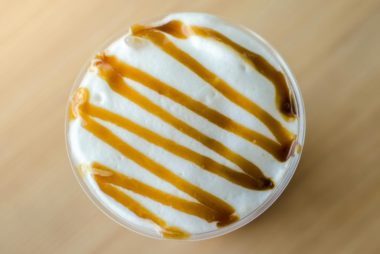 WORRATHANAWAT/SHUTTERSTOCKThe second kind of beverage Planells puts at the bottom of the nutrition list is that sweet-topped coffee treat. "Do we really need an extra three teaspoons of chocolate syrup when one will do?" he points out. If you deserve a big splurge for the day, just ask your barista to go light on the toppings (they're so intensely flavorful a little goes a long way), or choose a simple latte. (Here's exactly how many calories you add when you trick out your coffee.)
WORRATHANAWAT/SHUTTERSTOCKThe second kind of beverage Planells puts at the bottom of the nutrition list is that sweet-topped coffee treat. "Do we really need an extra three teaspoons of chocolate syrup when one will do?" he points out. If you deserve a big splurge for the day, just ask your barista to go light on the toppings (they're so intensely flavorful a little goes a long way), or choose a simple latte. (Here's exactly how many calories you add when you trick out your coffee.)Protein bars
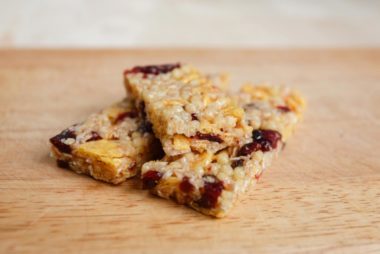 ALEKSEY KORCHEMKIN/SHUTTERSTOCKWhile there are many different kinds of protein bars, in most cases the nutrition info on the back of the package might surprise you. "Unless organic, most protein bars are highly processed, even featuring artificial ingredients and fillers," says Shape.com. "Bottom line, if your protein bar has more than 200 calories or eight grams of sugar, it's more like a candy bar with added protein than health food." (Here are 35 ways nutritionists sneak more protein into their diet.)
ALEKSEY KORCHEMKIN/SHUTTERSTOCKWhile there are many different kinds of protein bars, in most cases the nutrition info on the back of the package might surprise you. "Unless organic, most protein bars are highly processed, even featuring artificial ingredients and fillers," says Shape.com. "Bottom line, if your protein bar has more than 200 calories or eight grams of sugar, it's more like a candy bar with added protein than health food." (Here are 35 ways nutritionists sneak more protein into their diet.)Potato chips...but not for the reason you think
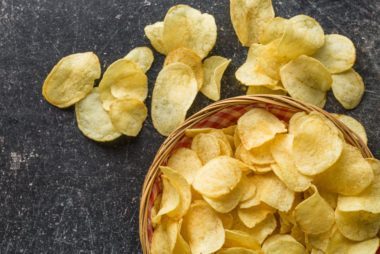 JIRI HERA/SHUTTERSTOCKNot only do processed and seasoned foods, like chips, contain extra salt that makes them mouth-wateringly tasty, says Mills, the type of sodium used in that processing does not have iodine—an element essential to the production of our thyroid hormone. "Even though there may be some justification to salting some of those foods, we're not getting the benefit of that iodine," she explains. "People who don't eat a lot of seafood may have difficulty getting their iodine, and they can't depend on those processed, salty snack foods to compensate." (By the way, watch out: your salt might be contaminated with tiny pieces of plastic.)
JIRI HERA/SHUTTERSTOCKNot only do processed and seasoned foods, like chips, contain extra salt that makes them mouth-wateringly tasty, says Mills, the type of sodium used in that processing does not have iodine—an element essential to the production of our thyroid hormone. "Even though there may be some justification to salting some of those foods, we're not getting the benefit of that iodine," she explains. "People who don't eat a lot of seafood may have difficulty getting their iodine, and they can't depend on those processed, salty snack foods to compensate." (By the way, watch out: your salt might be contaminated with tiny pieces of plastic.)Microwave popcorn
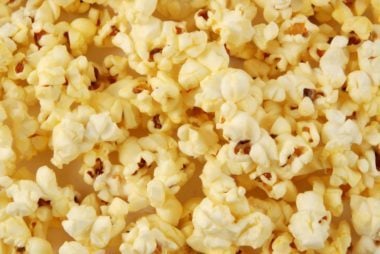 VALERI POTAPOVA/SHUTTERSTOCKPutting the popcorn itself aside, it's the packaging that warrants concern. That microwave-safe bag is lined with a chemical called PFOA, or perfluorooctanoic acid, says NaturalON.com. "Maybe you have heard the warning that your non-stick pots and pans are toxic? Your microwave popcorn is lined with the same toxic non-stick lining. When heated this chemical has been shown to cause cancer and infertility in lab animals," according to the site. Here's how you can make homemade microwave popcorn, sans the toxic bag.
VALERI POTAPOVA/SHUTTERSTOCKPutting the popcorn itself aside, it's the packaging that warrants concern. That microwave-safe bag is lined with a chemical called PFOA, or perfluorooctanoic acid, says NaturalON.com. "Maybe you have heard the warning that your non-stick pots and pans are toxic? Your microwave popcorn is lined with the same toxic non-stick lining. When heated this chemical has been shown to cause cancer and infertility in lab animals," according to the site. Here's how you can make homemade microwave popcorn, sans the toxic bag.Fruit "drinks"
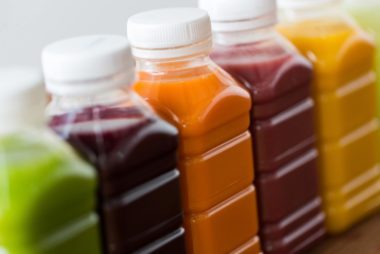 SYDA PRODUCTIONS/SHUTTERSTOCKWhen you're choosing a juice, make sure the bottle says 100-percent fruit juice. "Fruit punches or fruit drinks are usually concentrates with added sugar," Planells explains. "So if you get something that's only 80-percent fruit juice and has an extra 20 grams of sugar, you could have eaten a piece of fruit and saved yourself all those extra calories." And remember, he adds, portion size, portion size, portion size: "Juice is usually a 6-oz serving." (These fruit juices, on the other hand, are great for you.)
SYDA PRODUCTIONS/SHUTTERSTOCKWhen you're choosing a juice, make sure the bottle says 100-percent fruit juice. "Fruit punches or fruit drinks are usually concentrates with added sugar," Planells explains. "So if you get something that's only 80-percent fruit juice and has an extra 20 grams of sugar, you could have eaten a piece of fruit and saved yourself all those extra calories." And remember, he adds, portion size, portion size, portion size: "Juice is usually a 6-oz serving." (These fruit juices, on the other hand, are great for you.)Flavored water
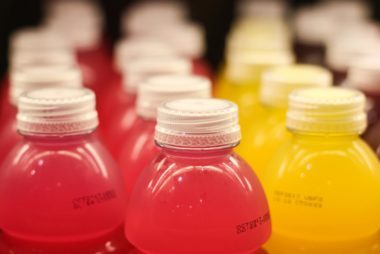 NICOLE S GLASS/SHUTTERSTOCKWhile Planells encourages drinking water to stay hydrated, he cautions against getting carried away with flavored varieties. "People think, 'It's water! It's got vitamins! It sounds healthy!' But read the label to understand what you're consuming," he says. "An 8-oz serving provides 50 calories, but a usual bottle is 16 to 20 ounces, so make sure you look at the serving per bottle. You could be consuming an additional 130 calories from your flavored water." (Here are 10 delicious fruit-infused water recipes you can make yourself.)
NICOLE S GLASS/SHUTTERSTOCKWhile Planells encourages drinking water to stay hydrated, he cautions against getting carried away with flavored varieties. "People think, 'It's water! It's got vitamins! It sounds healthy!' But read the label to understand what you're consuming," he says. "An 8-oz serving provides 50 calories, but a usual bottle is 16 to 20 ounces, so make sure you look at the serving per bottle. You could be consuming an additional 130 calories from your flavored water." (Here are 10 delicious fruit-infused water recipes you can make yourself.)
CONTENT CONTINUES BELOW AD
Dried fruit
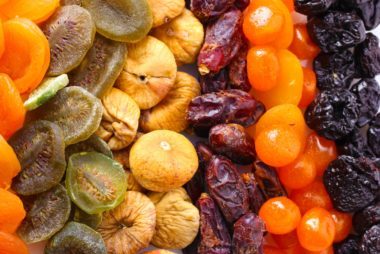 AFRICA STUDIO/SHUTTERSTOCKWhile a snack bag full of dried fruit may seem like sensible choice, keep the serving size in perspective. "Would you eat seven mangoes in one sitting? Or 12 peaches? Because dried fruit is pretty much just that. Fruit that has been shrunken down and extracted of its moisture—but the natural sugars remain," explains Shape.com. Our bodies just aren't designed to handle all that sugar in one sitting, the site adds. (Here are 11 yummy after-school snacks that nutritionists give to their own kids.)
AFRICA STUDIO/SHUTTERSTOCKWhile a snack bag full of dried fruit may seem like sensible choice, keep the serving size in perspective. "Would you eat seven mangoes in one sitting? Or 12 peaches? Because dried fruit is pretty much just that. Fruit that has been shrunken down and extracted of its moisture—but the natural sugars remain," explains Shape.com. Our bodies just aren't designed to handle all that sugar in one sitting, the site adds. (Here are 11 yummy after-school snacks that nutritionists give to their own kids.)The uncut watermelon
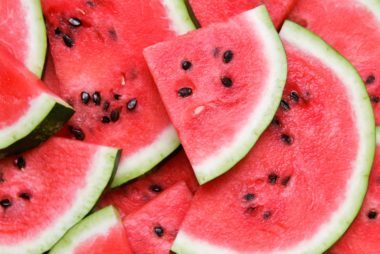 OLGA-MALYSHEVA/SHUTTERSTOCKOne key to healthy snacking is accessibility, Planells points out. "If you have a watermelon sitting on your counter, it looks beautiful, but nobody is going to touch it," he says. "But if you cut it and store it in a container you can easily see in the front of your fridge, it's very easy to pull it out and eat it." Here are the secrets to picking out the perfect watermelon.
OLGA-MALYSHEVA/SHUTTERSTOCKOne key to healthy snacking is accessibility, Planells points out. "If you have a watermelon sitting on your counter, it looks beautiful, but nobody is going to touch it," he says. "But if you cut it and store it in a container you can easily see in the front of your fridge, it's very easy to pull it out and eat it." Here are the secrets to picking out the perfect watermelon.Fruit cocktail
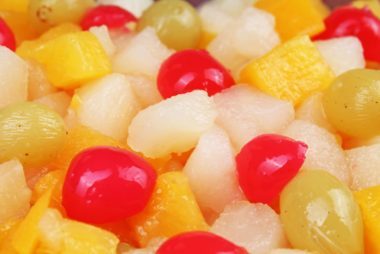 NALAPHOTOS/SHUTTERSTOCKThe problem is, it isn't just fruit. "Most fruit cocktails are made with a sugary syrup that does nothing but drive the calories up without adding any nutritional value," says Shape.com, which suggests eating one or two pieces of fresh fruit instead. (This is how much fruit you should be eating every day.)
NALAPHOTOS/SHUTTERSTOCKThe problem is, it isn't just fruit. "Most fruit cocktails are made with a sugary syrup that does nothing but drive the calories up without adding any nutritional value," says Shape.com, which suggests eating one or two pieces of fresh fruit instead. (This is how much fruit you should be eating every day.)Cookies from a package
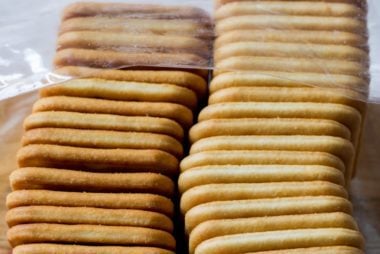 PHOTOSIBER/SHUTTERSTOCKWho hasn't dipped into a box or bag of prepackaged cookies to quell an afternoon craving? But NaturalON.comlists all the reasons to resist this temptation: "Check the label to see if they are made with partially hydrogenated cooking oil. If they are, put them back," the site warns. "If you read the label carefully, you will see that they contain white flour, tons of sugar, artificial flavors, colors, and simply tons of preservatives." Instead, the site suggests enjoying some homemade cookies you've baked yourself. Here's how to bake the perfect chocolate chip cookie.
PHOTOSIBER/SHUTTERSTOCKWho hasn't dipped into a box or bag of prepackaged cookies to quell an afternoon craving? But NaturalON.comlists all the reasons to resist this temptation: "Check the label to see if they are made with partially hydrogenated cooking oil. If they are, put them back," the site warns. "If you read the label carefully, you will see that they contain white flour, tons of sugar, artificial flavors, colors, and simply tons of preservatives." Instead, the site suggests enjoying some homemade cookies you've baked yourself. Here's how to bake the perfect chocolate chip cookie.Chocolate
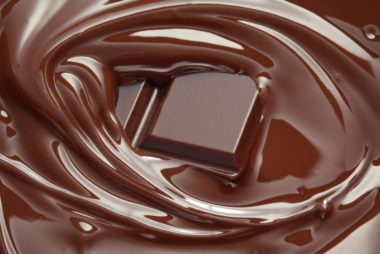 SHULEVSKYY-VOLODYMYR/SHUTTERSTOCKEven though we've all heard about the health benefits of chocolate, it's important not to get carried away. "Chocolate provides us with great things like antioxidants, but milk chocolate also contains lots of sugar," says Mills. Your best bet, she adds, is to choose a dark chocolate that is 60-70 percent cacao, which is packed with healthy flavonoids. Portion size is also important. "If you're thinking about a regular-sized, high-end chocolate bar, you may just need 1-2 squares to get the benefits without over-doing it on the calories and fat," Mills says.
SHULEVSKYY-VOLODYMYR/SHUTTERSTOCKEven though we've all heard about the health benefits of chocolate, it's important not to get carried away. "Chocolate provides us with great things like antioxidants, but milk chocolate also contains lots of sugar," says Mills. Your best bet, she adds, is to choose a dark chocolate that is 60-70 percent cacao, which is packed with healthy flavonoids. Portion size is also important. "If you're thinking about a regular-sized, high-end chocolate bar, you may just need 1-2 squares to get the benefits without over-doing it on the calories and fat," Mills says.Stick margarine
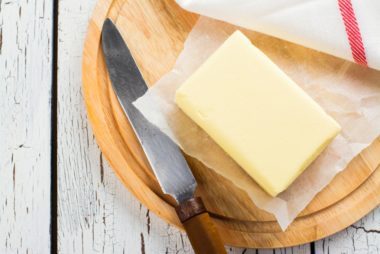 EKATERINA-MARKELOVA/SHUTTERSTOCKDespite its reputation as a healthier butter alternative, "stick margarine contains excessive amounts of trans-fats, the ones that cause damage to your blood vessels and arteries, not to mention the calories," says NaturalON.com. "Most stick margarine has at least 100 calories in one tablespoon!" The site recommends butter as a better choice—margarine is definitely one of the worst foods you can eat.
EKATERINA-MARKELOVA/SHUTTERSTOCKDespite its reputation as a healthier butter alternative, "stick margarine contains excessive amounts of trans-fats, the ones that cause damage to your blood vessels and arteries, not to mention the calories," says NaturalON.com. "Most stick margarine has at least 100 calories in one tablespoon!" The site recommends butter as a better choice—margarine is definitely one of the worst foods you can eat.Gummy fruit snacks
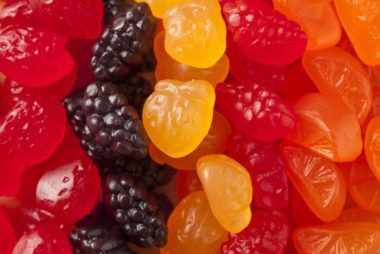 BRENT HOFACKER/SHUTTERSTOCKThe word "fruit" in a food's name makes it seem like it's not the world's worst choice, but fruit roll-ups and gummy fruit snacks aren't your best option. "Even if it's all natural, you're better off eating a piece of real fruit," says Shape.com. "You'll be more satiated, you'll consume less sugar and calories, and you'll get more nutrition." (These are the most filling fruits and vegetables.)
BRENT HOFACKER/SHUTTERSTOCKThe word "fruit" in a food's name makes it seem like it's not the world's worst choice, but fruit roll-ups and gummy fruit snacks aren't your best option. "Even if it's all natural, you're better off eating a piece of real fruit," says Shape.com. "You'll be more satiated, you'll consume less sugar and calories, and you'll get more nutrition." (These are the most filling fruits and vegetables.)Artificial sweeteners on anything
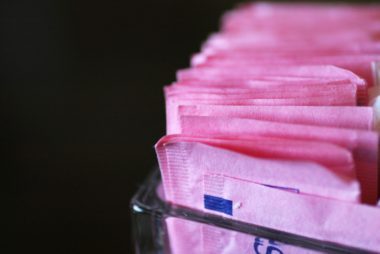 KEVIN LEPP/SHUTTERSTOCKThink twice before choosing one of those blue, yellow, or pink sweetener packets over sugar. "Artificial sweeteners inhibit your body's natural ability to know when it has consumed too many calories so you will, more than likely, overeat," says NaturalON.com. "These chemical sweeteners also seem to make your body crave even more sweets!" Instead of artificial sweeteners, consider these natural alternatives.
KEVIN LEPP/SHUTTERSTOCKThink twice before choosing one of those blue, yellow, or pink sweetener packets over sugar. "Artificial sweeteners inhibit your body's natural ability to know when it has consumed too many calories so you will, more than likely, overeat," says NaturalON.com. "These chemical sweeteners also seem to make your body crave even more sweets!" Instead of artificial sweeteners, consider these natural alternatives.Ranch dressing
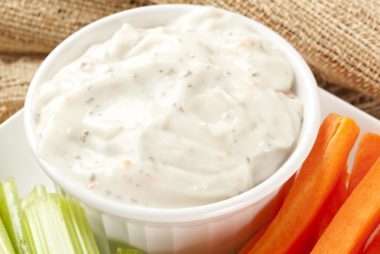 BRENT HOFACKER/SHUTTERSTOCKThis condiment may seem a reasonable snack component, especially when used as a dip for fresh veggies. But don't overdo it. "Each tablespoon (and that's not much) has more than 75 calories. What most people would consider a 'normal' serving, at least one ounce, has 137 calories and more than 7 grams of fat!" according to NaturalON.com. As if that's not enough: "Ranch dressing is also loaded with sugar, modified food starch, artificial flavors, artificial colors, and malt dextrin, all things you don't need," the site explains. Here are some other condiments that are bad for your health.
BRENT HOFACKER/SHUTTERSTOCKThis condiment may seem a reasonable snack component, especially when used as a dip for fresh veggies. But don't overdo it. "Each tablespoon (and that's not much) has more than 75 calories. What most people would consider a 'normal' serving, at least one ounce, has 137 calories and more than 7 grams of fat!" according to NaturalON.com. As if that's not enough: "Ranch dressing is also loaded with sugar, modified food starch, artificial flavors, artificial colors, and malt dextrin, all things you don't need," the site explains. Here are some other condiments that are bad for your health.French fries
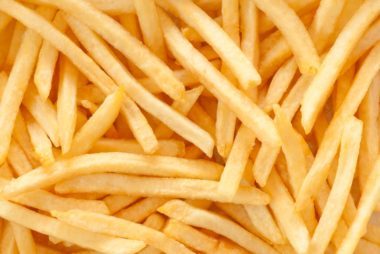 TULPAHN/SHUTTERSTOCKIt's hard not to love French fries, but new research is linking these savory spuds to an increased risk of death. A 2017 study in the American Journal of Clinical Nutrition looked at the potato eating habits of 4,400 people over eight years and found that "eating fried potatoes—including French fries, fried potatoes, and hash browns—at least two times per week was linked to a more than doubled risk of death," reported TIME.com, which pointed out the high levels of fat and salt fried potatoes usually contain.
TULPAHN/SHUTTERSTOCKIt's hard not to love French fries, but new research is linking these savory spuds to an increased risk of death. A 2017 study in the American Journal of Clinical Nutrition looked at the potato eating habits of 4,400 people over eight years and found that "eating fried potatoes—including French fries, fried potatoes, and hash browns—at least two times per week was linked to a more than doubled risk of death," reported TIME.com, which pointed out the high levels of fat and salt fried potatoes usually contain.Ketchup
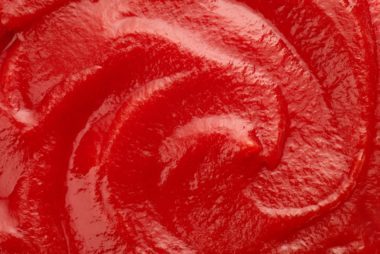 MARAZE/SHUTTERSTOCKIf you've decided to dip those fries in some ketchup, your health is likely taking another hit. In addition to the fact that ketchups can be packed with high fructose corn syrup, extra salt, artificial colors, artificial flavors, and preservatives, "the ketchup is usually listed as being from concentrate, which means it's been heated and boiled down," says NaturalON.com. "This removes many of the nutrients that would give it any health benefits." For more control over your ketchup contents, try this homemade ketchup recipe.
MARAZE/SHUTTERSTOCKIf you've decided to dip those fries in some ketchup, your health is likely taking another hit. In addition to the fact that ketchups can be packed with high fructose corn syrup, extra salt, artificial colors, artificial flavors, and preservatives, "the ketchup is usually listed as being from concentrate, which means it's been heated and boiled down," says NaturalON.com. "This removes many of the nutrients that would give it any health benefits." For more control over your ketchup contents, try this homemade ketchup recipe.Deli meats
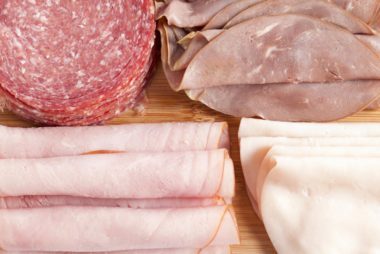 DAN KOSMAYER/SHUTTERSTOCKIf you reach for a few rolled-up, prepackaged deli meats when you want a snack, you may not be doing yourself any favors. Those convenient slices are full of nitrates, sodium, additives, and preservatives, according to Activebeat.com, which says, "Adults who regularly partake risk increased rates of heart disease, and cancer. While studies show that meat lunching kids are prone to learning issues and behavioral conditions." For a safer alternative, the site suggests buying chicken breasts and slicing them into strips that you can use in sandwiches throughout the week. (Here's what you should really be eating to live to 100.)
DAN KOSMAYER/SHUTTERSTOCKIf you reach for a few rolled-up, prepackaged deli meats when you want a snack, you may not be doing yourself any favors. Those convenient slices are full of nitrates, sodium, additives, and preservatives, according to Activebeat.com, which says, "Adults who regularly partake risk increased rates of heart disease, and cancer. While studies show that meat lunching kids are prone to learning issues and behavioral conditions." For a safer alternative, the site suggests buying chicken breasts and slicing them into strips that you can use in sandwiches throughout the week. (Here's what you should really be eating to live to 100.)Cookie dough
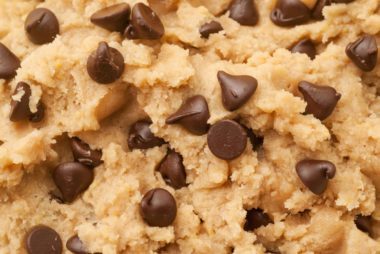 NICK LUNDGREN/SHUTTERSTOCKYou already know not to nosh raw cookie dough due to the risk of salmonella in the uncooked eggs. But did you know the uncooked flour could be a problem as well? In 2016 General Mills issued a recall 10 million pounds of flour due to concerns over an E. coli outbreak that had sickened people in 20 states, reported the Los Angeles Times. "So it's not only cookie dough that could make you sick—it's anything you made with flour but haven't cooked. However, most of us probably aren't sampling bread dough or breaded chicken breasts while they're still raw," said the paper, which explained E. coli bacteria are killed by heat.
NICK LUNDGREN/SHUTTERSTOCKYou already know not to nosh raw cookie dough due to the risk of salmonella in the uncooked eggs. But did you know the uncooked flour could be a problem as well? In 2016 General Mills issued a recall 10 million pounds of flour due to concerns over an E. coli outbreak that had sickened people in 20 states, reported the Los Angeles Times. "So it's not only cookie dough that could make you sick—it's anything you made with flour but haven't cooked. However, most of us probably aren't sampling bread dough or breaded chicken breasts while they're still raw," said the paper, which explained E. coli bacteria are killed by heat.Packaged snack mixes
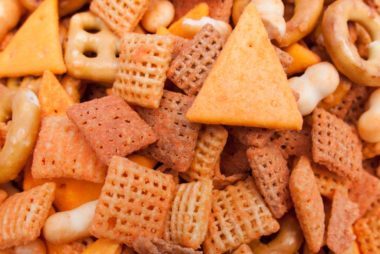 SHANE TROTTER/SHUTTERSTOCKSnack-sized bags of party mixes can have "over-the-top" salt levels reported FOXNews.com, which called out two name brands that contained 400-470 mg of sodium. For reference, the American Heart Association sets the "ideal limit" of daily salt consumption at no more than 1,500 mg for most adults, so think twice before scarfing down so much of your sodium allowance in one sitting. (Quiz: can you spot the salt in your food?)
SHANE TROTTER/SHUTTERSTOCKSnack-sized bags of party mixes can have "over-the-top" salt levels reported FOXNews.com, which called out two name brands that contained 400-470 mg of sodium. For reference, the American Heart Association sets the "ideal limit" of daily salt consumption at no more than 1,500 mg for most adults, so think twice before scarfing down so much of your sodium allowance in one sitting. (Quiz: can you spot the salt in your food?)Canned peaches
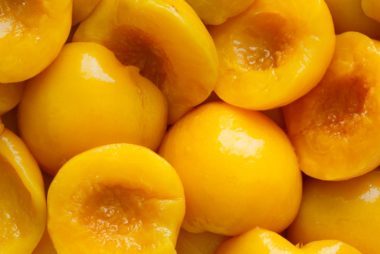 MOVING MOMENT/SHUTTERSTOCKThe fact that canned fruits, including the always popular canned peaches, are packed with extra sugar is only part of the problem. In addition, "their nutrient content is typically much lower than fresh and frozen fruits and vegetables, which are flash frozen at the peak of ripeness," according to Shape.com. What's more cans are typically lined with a preservative that's in fact a toxic chemical, the site adds. (Here are some signs you're eating too many preservatives.)
MOVING MOMENT/SHUTTERSTOCKThe fact that canned fruits, including the always popular canned peaches, are packed with extra sugar is only part of the problem. In addition, "their nutrient content is typically much lower than fresh and frozen fruits and vegetables, which are flash frozen at the peak of ripeness," according to Shape.com. What's more cans are typically lined with a preservative that's in fact a toxic chemical, the site adds. (Here are some signs you're eating too many preservatives.)Fruit-filled muffins
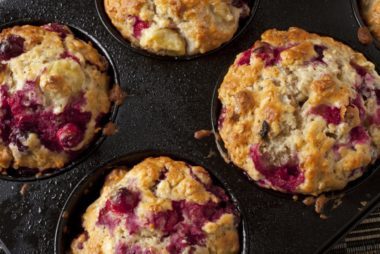 ALEXANDRALAW1977/SHUTTERSTOCKSomething about a muffin just feels wholesome, especially when it's packed with fruit. But they're nothing more than "sugar-laden calorie bombs," Kate Kennedy, RD, told Shape.com, which also accuses this breakfast basic of having "artificial flavorings, added sugars, and ridiculous portion sizes." The site recommends that you bake your own at home, and to think of muffins as a once-in-awhile treat rather than an everyday staple. Think twice before eating these nine other breakfast foods that may be sabotaging your health.
ALEXANDRALAW1977/SHUTTERSTOCKSomething about a muffin just feels wholesome, especially when it's packed with fruit. But they're nothing more than "sugar-laden calorie bombs," Kate Kennedy, RD, told Shape.com, which also accuses this breakfast basic of having "artificial flavorings, added sugars, and ridiculous portion sizes." The site recommends that you bake your own at home, and to think of muffins as a once-in-awhile treat rather than an everyday staple. Think twice before eating these nine other breakfast foods that may be sabotaging your health.Club and cheese crackers
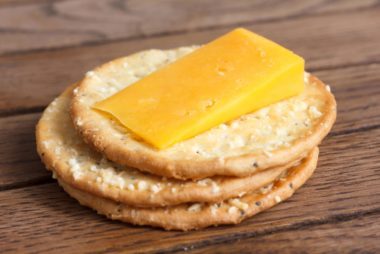 MOVING MOMENT/SHUTTERSTOCKA cracker may seem a healthier choice than a cookie or chip, but don't get too cozy with this common snack. "One serving probably won't fill you up since these crackers are low in water, volume, protein, and fiber," says WebMD.com, "So you'll probably double the serving—which means your snack now contains double the calories, grams of fat, saturated fat, and milligrams of sodium." (Here are 27 foods you should never, ever buy again.)
MOVING MOMENT/SHUTTERSTOCKA cracker may seem a healthier choice than a cookie or chip, but don't get too cozy with this common snack. "One serving probably won't fill you up since these crackers are low in water, volume, protein, and fiber," says WebMD.com, "So you'll probably double the serving—which means your snack now contains double the calories, grams of fat, saturated fat, and milligrams of sodium." (Here are 27 foods you should never, ever buy again.)Tea drinks
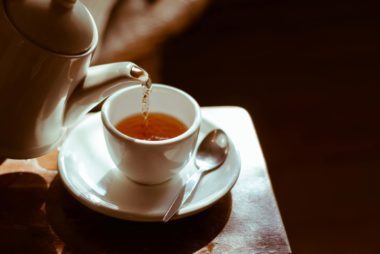 WIRO.KLYNGZ/SHUTTERSTOCKTea by itself is a great idea. (It has so many health benefits!) But that's only when you brew it yourself and control exactly what's in it, says Shape.com. "When you buy flavored tea in a bottle or can? Lots of added sugar, sodium, and artificial flavorings get involved, making this drink less than ideal," the site warns.
WIRO.KLYNGZ/SHUTTERSTOCKTea by itself is a great idea. (It has so many health benefits!) But that's only when you brew it yourself and control exactly what's in it, says Shape.com. "When you buy flavored tea in a bottle or can? Lots of added sugar, sodium, and artificial flavorings get involved, making this drink less than ideal," the site warns.Veggie straws or sticks
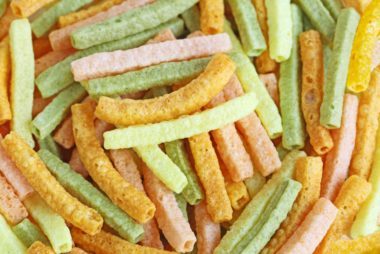 LE DO/SHUTTERSTOCK"They're like a wolf in sheep's clothing," Anna Taylor, MS, RD, LD, said of veggie sticks in a Cleveland Clinic listing of "worst snacks your dietitian would never eat." While they may be slightly lower in fat than chips, these snacks don't offer protein or fiber and are essentially "devoid of nutrients," Taylor added. (Here's how you can eat more healthy veggies without even trying.)
LE DO/SHUTTERSTOCK"They're like a wolf in sheep's clothing," Anna Taylor, MS, RD, LD, said of veggie sticks in a Cleveland Clinic listing of "worst snacks your dietitian would never eat." While they may be slightly lower in fat than chips, these snacks don't offer protein or fiber and are essentially "devoid of nutrients," Taylor added. (Here's how you can eat more healthy veggies without even trying.)Artichoke spinach dip
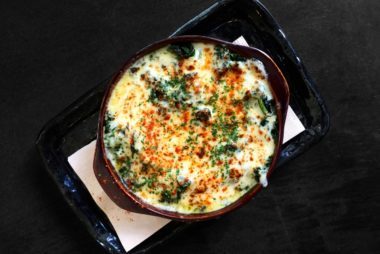 SUMROENG-CHINNAPA/SHUTTERSTOCKTwo veggies in one food may sound like good deal, but not in the case of artichoke spinach dip ordered at a restaurant. "Be warned. Just a few tablespoons can pack hundreds of calories and unhealthy fat grams," says Shape.com, which instead suggests making this snack at home, and dipping raw veggies instead of chips. (Here are some signs you're eating too much bad fat.)
SUMROENG-CHINNAPA/SHUTTERSTOCKTwo veggies in one food may sound like good deal, but not in the case of artichoke spinach dip ordered at a restaurant. "Be warned. Just a few tablespoons can pack hundreds of calories and unhealthy fat grams," says Shape.com, which instead suggests making this snack at home, and dipping raw veggies instead of chips. (Here are some signs you're eating too much bad fat.)Sprouts
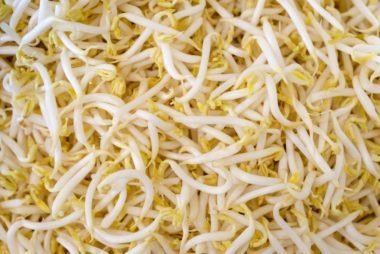 ANTPKR/SHUTTERSTOCKIt's not the sprout itself that's a concern; it's the bacterial contamination that may come with it. "The very thing that makes sprouts grow, warm moist conditions, are also the ideal conditions for making bacteria like salmonella, E.coli, and listeria grow," says NaturalON.com, which cites numerous recalls due to bacterial contamination of alfalfa, pea, and bean sprouts. (Make sure you follow these food safety tips to protect yourself from foodborne illness.)
ANTPKR/SHUTTERSTOCKIt's not the sprout itself that's a concern; it's the bacterial contamination that may come with it. "The very thing that makes sprouts grow, warm moist conditions, are also the ideal conditions for making bacteria like salmonella, E.coli, and listeria grow," says NaturalON.com, which cites numerous recalls due to bacterial contamination of alfalfa, pea, and bean sprouts. (Make sure you follow these food safety tips to protect yourself from foodborne illness.)Blue corn chips
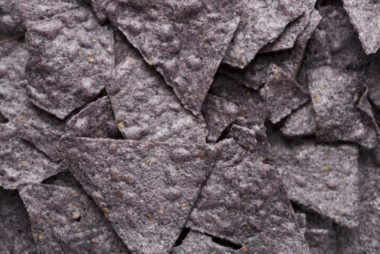 AMBIENT-IDEAS/SHUTTERSTOCKBlue chips just seem better than yellow or white corn tortilla chips. "But they really aren't that different, thanks to similar calorie, fat, and sodium counts," says Shape.com. So eat them with the same restraint you'd use for their lighters cousins. (Here's what the color of your food reveals.)
AMBIENT-IDEAS/SHUTTERSTOCKBlue chips just seem better than yellow or white corn tortilla chips. "But they really aren't that different, thanks to similar calorie, fat, and sodium counts," says Shape.com. So eat them with the same restraint you'd use for their lighters cousins. (Here's what the color of your food reveals.)Store-bought smoothies
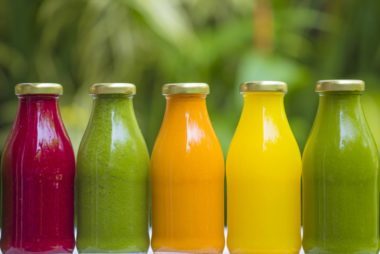 TRUBAVIN/SHUTTERSTOCKNot all smoothies are created equal, Jennifer Willoughby, RD, CSP, LD, told the Cleveland Clinic. "Home-made smoothies can be power-packed with nutrients," she said. "But grab-and-go smoothies, even from your best local smoothie shop or grocery store, are often jam-packed with added sugar (often, from fruit juice) and calories. You can run up 300-700 calories with this quick 'snack,' which won't keep you feeling full like a good snack should!" Try one of these eight healthy fruit smoothie recipes.
TRUBAVIN/SHUTTERSTOCKNot all smoothies are created equal, Jennifer Willoughby, RD, CSP, LD, told the Cleveland Clinic. "Home-made smoothies can be power-packed with nutrients," she said. "But grab-and-go smoothies, even from your best local smoothie shop or grocery store, are often jam-packed with added sugar (often, from fruit juice) and calories. You can run up 300-700 calories with this quick 'snack,' which won't keep you feeling full like a good snack should!" Try one of these eight healthy fruit smoothie recipes.Baked beans
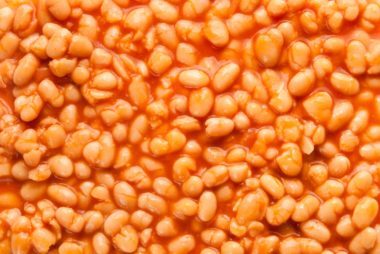 NILS-Z/SHUTTERSTOCKAs a high-fiber food and plant-based protein source, beans by themselves are fantastic. "But baked beans—particularly the canned kinds in all flavors—can also be extremely high in sodium, sugar, and additives," says Shape.com, which recommends reading the label or making a homemade batch so you can control the seasoning. (Here are some other foods that have way more salt than you thought.)
NILS-Z/SHUTTERSTOCKAs a high-fiber food and plant-based protein source, beans by themselves are fantastic. "But baked beans—particularly the canned kinds in all flavors—can also be extremely high in sodium, sugar, and additives," says Shape.com, which recommends reading the label or making a homemade batch so you can control the seasoning. (Here are some other foods that have way more salt than you thought.)
CONTENT CONTINUES BELOW AD
Coleslaw
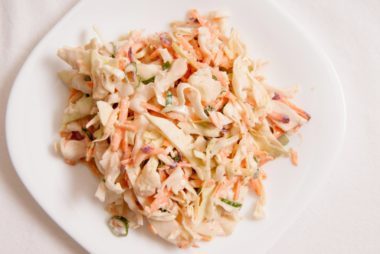 FARBLED/SHUTTERSTOCKThis tasty food with its mix of veggies may seem an innocent add-on to a summery meal, but it might not be the best choice. "True, it contains cabbage and carrots, both of which are very good for you, but it is simply loaded with calories, sugars, and a tremendous amount of fat," according to NaturalON.com. The fat comes from the mayonnaise, says the site, which explains that chain brands, like KFC, contain more fat in a coleslaw serving (22 grams) than a large French fries serving (19 grams.) (Here are 20 tricks to eating healthy while eating ou
FARBLED/SHUTTERSTOCKThis tasty food with its mix of veggies may seem an innocent add-on to a summery meal, but it might not be the best choice. "True, it contains cabbage and carrots, both of which are very good for you, but it is simply loaded with calories, sugars, and a tremendous amount of fat," according to NaturalON.com. The fat comes from the mayonnaise, says the site, which explains that chain brands, like KFC, contain more fat in a coleslaw serving (22 grams) than a large French fries serving (19 grams.) (Here are 20 tricks to eating healthy while eating ou- লিঙ্ক পান
- X
- ইমেল
- অন্যান্য অ্যাপ
মন্তব্যসমূহ
একটি মন্তব্য পোস্ট করুন